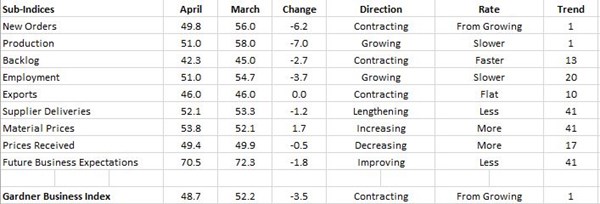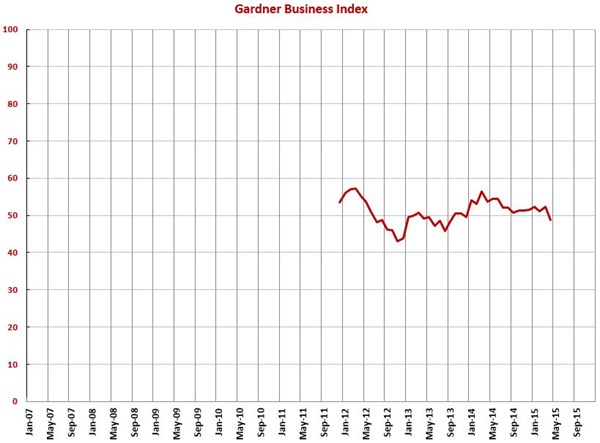April GBI at 48.7 – Growth Streak Ends at 15 Months
Compared with one year ago, the index has contracted for four straight months.
#economics
With a reading of 48.7, the Gardner Business Index showed that durable goods manufacturing contracted for the first time since December 2013, ending 15 straight months of growth. This also ended the trend of accelerating growth for durable goods manufacturing that began back in September 2014. And, each month the rate of contraction has accelerated. The annual rate of change was just 2.5% in April, which was the slowest rate of growth since February 2014.
New orders contracted for the first time in 18 months. The indexed dropped significantly from last month. Production continued to expand, but the rate of expansion was the slowest since December 2013. The good news is that orders and production are coming into a better balance when comparing the historical ratio between the two. Backlogs continued to contract. The backlog index has been on a steady down trend since March 2014 and was at its lowest level since September 2013. The trend in backlogs indicated that the industry has seen the peak rate of growth in capacity utilization. While employment continued to increase, the index was at its lowest level since December 2013. Exports have contracted at a fairly constant rate since August 2014 due to the relatively strong dollar. Supplier deliveries lengthened at their slowest pace since August 2013, indicating a general slowdown throughout manufacturing.
Material prices increased at a faster rate than last month. Although, the rate of increase in material prices was historically quite low. Prices received decreased a minimal rate for the second straight month. Future business expectations fell to their lowest level since October 2014.
All plant sizes recorded a decline in their index. Facilities with more than 50 employees continued to grow but those with 100-249 employees were the only ones with a significant rate of growth. After expanding for three months, companies with 20-49 employees saw a slight contraction in business conditions. Companies with 1-19 employees contracted for the fourth month in a row. Their index was the lowest since August 2013.
Only two regions, the North Central – West and North Central – East, recorded minimal growth in April. While it had growth three of the four previous months, the West region was flat this month. The Northeast and Southeast moved from expansion to contraction. The South Central continued to contract with its index falling to its lowest level since the survey began in December 2011.
Only two industries, petrochemical processors and industrial motors/hydraulics/mechanical components, had any significant growth in April. Plastics/rubber products and machinery/equipment were just barely positive this month. All other industries contracted. From the slowest to fastest contraction, they were electronics/computers/telecommunication, forming/fabricating (non-auto), automotive, custom processors, metalcutting job shops, medical, primary metals, and pumps/valves/plumbing products.
In addition to the overall durable goods index, we compute indices for a number of technologies or processes. The plastics industry was the only one to expand in April and it barely did so. From the slowest to fastest contraction, the other industries were composites, moldmaking, finishing, screw machining, and metalworking.
Planned capital expenditures have been hit hard in recent months. April was the lowest planned spending since November 2012. In April, planned spending contracted 43.4% compared with one year ago. This was the eighth month in a row of month-over-month contraction. Annually, planned spending contracted at a rate of 11.5%, which was the sixth consecutive month of contraction.


RELATED CONTENT
-
Auto vs. Tech: Guess Who Wins
Matthew Simoncini, president and CEO of Lear Corp., provided some fairly compelling figures this week at the CAR Management Briefing Seminars that show just how out-of-whack the valuations of tech companies are vis-à-vis auto companies.
-
Is The V8 Dead?
Tougher fuel economy standards may be the end of most V8s.
-
Report Forecasts Huge Economic Upside for Self-Driving EVs
Widespread adoption of autonomous electric vehicles could provide $800 billion in annual social and economic benefits in the U.S. by 2050, according to a new report.


.JPG;width=70;height=70;mode=crop)